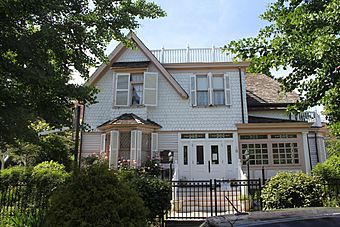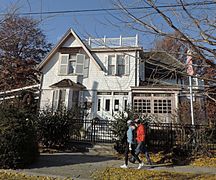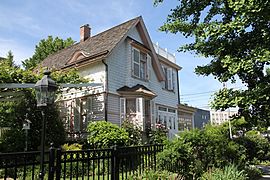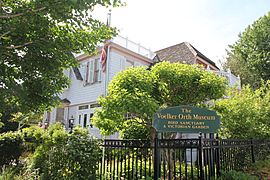Voelker Orth Museum facts for kids
|
Voelker Orth Museum, Bird Sanctuary, and Victorian Garden
|
|

Voelker Orth house from 38th Avenue
|
|
| Location | 149-19 38th Ave. Flushing, Queens, New York, United States |
|---|---|
| Built | c. 1891 |
| NRHP reference No. | 100005569 |
Quick facts for kids Significant dates |
|
| Added to NRHP | September 18, 2020 |
The Voelker Orth Museum, Bird Sanctuary, and Victorian Garden is a special museum in Queens, New York City. It is located at 149-19 38th Avenue in the Murray Hill neighborhood. This museum helps us learn about the past by showing us an 1890s home and garden. This home belonged to a family who moved to America from Germany.
The museum offers many fun activities. You can take tours of the house, see different art shows, and listen to concerts. They also have workshops, cultural events, and programs for families and schools. The museum's main goal is to share the history of Flushing, Queens, and its nearby areas. It does this by letting people experience what life was like in an immigrant family's home from the 1890s. This property was added to the National Register of Historic Places in 2020.
About the Museum House
The museum is in a two-story house built in 1891. A local businessman named James Bouton built it as an investment. This was two years after the Long Island Rail Road opened the Murray Hill train station nearby.
In 1899, a German immigrant named Conrad Voelcker bought the house. He moved in with his wife, Elizabeth, and their baby daughter, Theresa. After Conrad passed away in 1930, his daughter Theresa and her husband, Dr. Rudolph Orth, lived there. Their daughter, Elisabetha Orth, lived in the house for most of her life. She made sure that the museum would be created after she was gone.
When the museum was officially started, the house was carefully fixed up. This happened before it opened to the public in 2003. Old photos from the early 1900s helped the architects make the house look just right. The rooms inside show how the Orth family lived in the 1930s. The house became a New York City Landmark in 2007.
The Victorian Garden
One of the most special parts of the museum is its Victorian garden. This garden is cared for using old-fashioned methods from the 1700s. Gardeners prune plants by hand and use natural ways to help them grow. They also use natural ways to keep pests away.
The garden is also a safe place for birds. It has many types of berry bushes and trees that attract wild birds. You might see sparrows, mockingbirds, robins, cardinals, and blue jays. The museum also has a beehive! They collect honey from the bees to use in their educational programs and sell in their gift shop. In 2005, the Voelker Orth Museum Garden won a special award called the Long Island Nurserymen's and Landscapers Association's Gold Award.
The Voelcker Family Story
Conrad Voelcker was born in a place called Edenkoben, Germany. He came to the United States in 1881 when he was 19 years old. In 1884, he started his own printing business and a German newspaper called Der Pfälzer in Amerika.
Conrad lived in Manhattan, New Jersey, and Brooklyn before moving to the Murray Hill area of Flushing, Queens. He bought the house there. A few years before, Conrad had married Elizabeth Maibach. Their only daughter, Theresa, was about one year old when they moved. Moving to Flushing meant Conrad was bringing his family to a nice suburb of Manhattan. It was also a short trip to his work.
Conrad kept selling his newspaper until around 1917, when the United States joined World War I. He probably stopped because of strong feelings against Germans at that time. Conrad retired from his printing business in 1925. His nephew, Carl S. Voelcker, then took over the company.
Conrad's daughter, Theresa, married Dr. Rudolph Orth. He was a doctor who had served in World War I. Their first daughter, Elisabetha, was born in 1926. In 1935, they adopted a nine-year-old girl and named her Barbara.
Elisabetha Orth finished college at New York University in 1948. She studied English Literature. Then she went to the University of Texas and earned a master's degree in Theater. Elisabetha lived with her mother in the family home for many years after her father passed away in 1948. Barbara married Thomas Lipera and moved away.
Theresa Orth passed away in 1992. Elisabetha died three years later in 1995 from injuries after a car accident. In her will, Elisabetha Orth asked for the Voelker Orth Museum to be created. She wanted it to be a place where people could learn.
Gallery




